|
BULB LOG 06 --- 8th February 2006

Galanthus woronowii
Thanks to Mark Smyth's forum post, my thoughts that my Galanthus platyphylus, shown in last week's log, is nothing more than Galanthus woronowii have been confirmed. Mark explains on the forum it is the notch on the inner segment, seen above, that gives it away.

Winter pruning
One of the tasks we are trying to catch up on is the winter pruning. Having so many trees in a relatively small area means we have to manage them carefully or our garden would quickly turn into a forest. With some of the acers and birches I can prune them so they still look natural but the likes of the Acer 'Crimson King', shown above, does look bobbed at the moment with its new 'haircut' but once the leaves come out it will look ok. All these woody prunings are chipped or shredded and these are then spread onto the paths by the hedges. I do not compost them first but I do spread some general purpose fertiliser granules at the same time to compensate for the nitrogen that it takes to break them down.

Sowing lily seed
I have also been sowing my seed from the SRGC seed exchange. This is the ideal time to sow lily and nomocharis seed. I have only just sown my own garden collected seeds - I have found that if I sow them in August/September, when I sow my fritillaria seed, they germinate too quickly (sometimes within two weeks) and I have to try and take them through a winter. All this type of 'lily seed' gets sown on the surface and will be covered by 1 to 2 cms of 6mm grit.

Sowing Crocus and Narcissus
It is later than I would like to be sowing Narcissus and Crocus seed but because I have just received them I will sow them now since, even if they do not germinate until next year, they are not as susceptible as the papery lily type seed to rotting off in the damp summer conditions we get in NE Scotland. Also note that they are sown at least half way down the pot, and then the pot is filled to 2cms from the top and dressed with grit. Once sown the seed pots are placed outside to take all the weather can throw at them until germination.
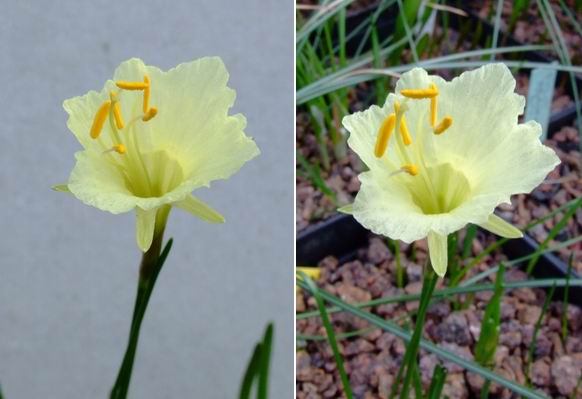
Narcissus romieuxii seedling
The highlight of growing plants from seed is when they flower for the first time and with bulbs you have to wait for a number of years so the pleasure is even greater. There has been much discussion on the forum about various cultivars of Narcissus romieuxii and indeed if you read about them you will quickly discover that the nomenclature of the entire Bulbicodium section is a bit sketchy to say the least. When you take that confusion and add the garden factor, where we are growing a wide range of these bulbs in very close proximity, then we get further cross fertilisation and a lot of variation. This is a nice seedling from N. romieuxii with a deeply notched corona that I have separated out to grow on as a clone. I have lots of good forms raised from seed and people have asked me for spare bulbs so before I pass them on I will give them a name. My big problem is the question: do we really need more named forms when there is already confusion with previously named forms? Well, I think there is a good case to
name these plants; they do not need to be officially registered until they have proved their worth. To prove their worth they would have to increase and flower well and be distinct enough to be picked out from the 'host of golden daffodils' - that is the test of time. It would cause more confusion not to name them and, as time goes by, only the very best and most distinct forms will persist and stay true to the name. The others may also be excellent plants but are maybe not distinct enough to justify their own name and these will have to be lumped into the conglomerate that we know as Narcissus romieuxii.
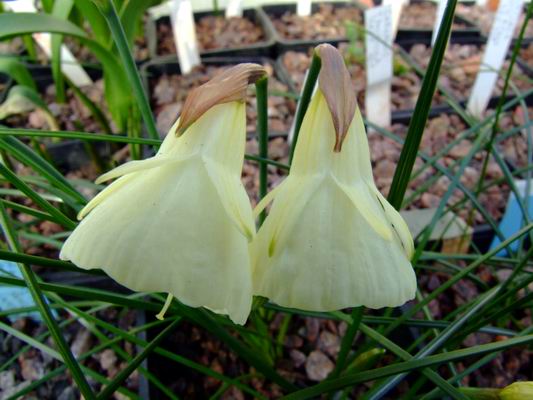
Narcissus 'Don Stead'
Narcissus 'Don Stead' is a good example of a good cultivar as it is distinct and can be easily picked out - it is not a selected form of romieuxii but a hybrid with N. bulbicodium.
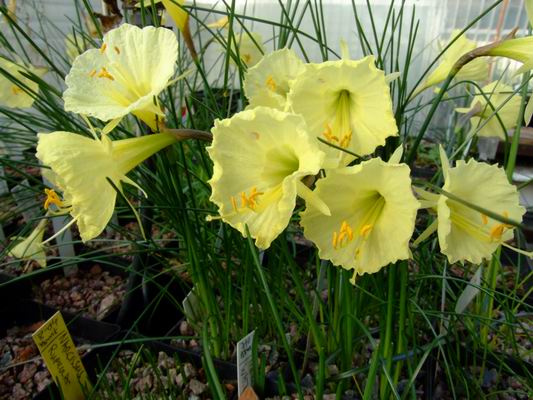
Narcissus romieuxii selection
I selected this form for its good colour, large flowers, which it produces freely each year, and its steady rate of increase but I fear it is not unique enough in its appearance to be picked out from the bunch. I could apply a number to it when I distribute it but then there is the temptation for someone else to give it a name - then we have a name and a number, then someone else gives it another name and we are adding to the confusion. I will continue with my policy of naming selected clones when I start to distribute them.
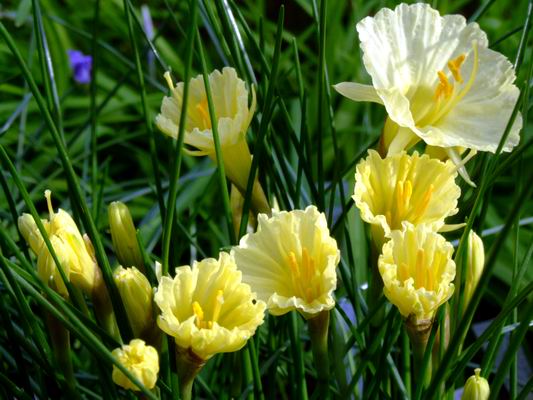
Narcissus romieuxii x mesatlanticus
Not of my making but this is an excellent bulb that flowers and increases well. The flowers are beautifully folded into the bud creating this wonderful pleated effect as they start to open. The flowers are quite yellow at first but fade to a very pale yellow by the time they are fully expanded - top right.

Narcissus unfolding
An extreme version of this pleated effect is seen in the expanding flower of this N. bulbicodium x romieuxii hybrid.
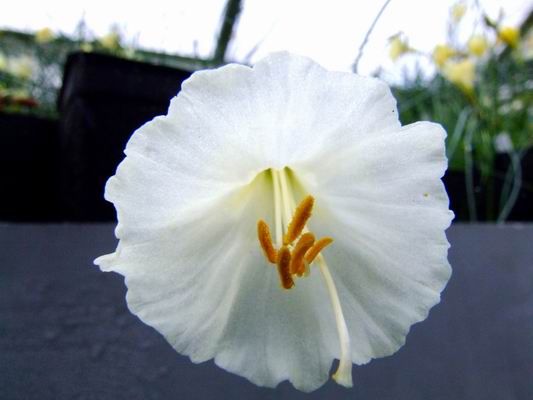
Narcissus growing in plunge
Another bulb seedling that self sowed into the plunge has a white flower and is probably a seedling from N. romieuxii mesatlanticus or N. 'Camoro' yes; that is yet another addition to this complex, most of the forms and hybrids are also fertile.
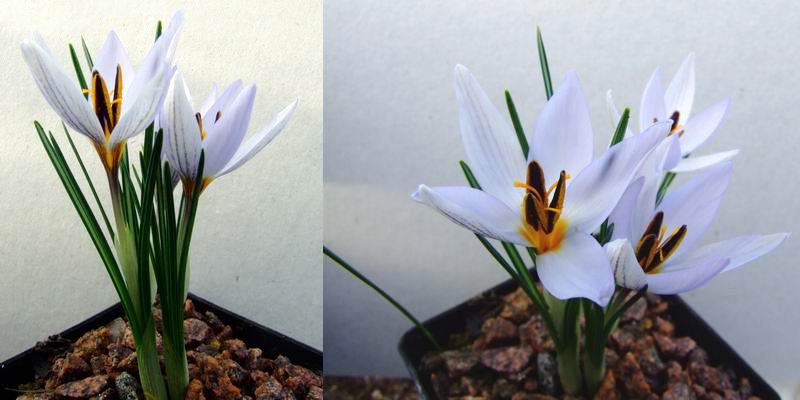
Crocus biflorus nubigena
Fortunately while there are some problems with the naming of Crocus the taxonomy is altogether clearer at least on the specific level - once we get into sub specific, forma and varietal status it is not so clear cut. Crocus biflorus nubigena is distinct from most other subspecies of biflorus in having dark anthers at least before they dehisce, that is once they open the pollen is yellow.
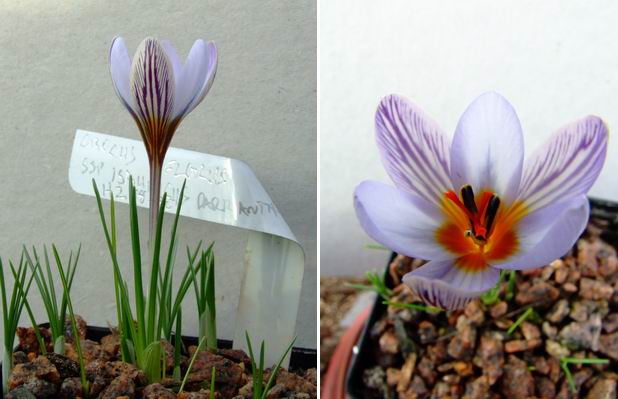
Crocus biflorus isauricus
As with all plant nomenclature there are going to be problems - I raised this Crocus biflorus isauricus from seed and it is quite unusual for this subspecies in having dark anthers; all the other plants we have as ssp. isauricus have normal coloured anthers.
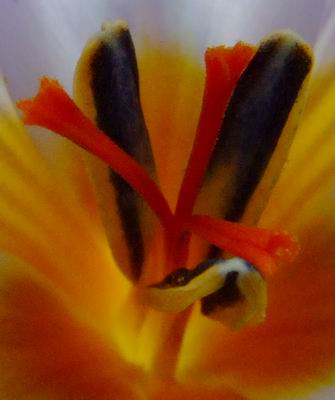
Crocus ultra close
I will leave you with an ultra close look at the anthers of this Crocus biflorus isauricus. I am still coming to terms with and learning the settings of my new camera: it is certainly capable of doing everything I want but I am not satisfied that I am completely in control yet. When you get a new camera it just takes a wee bit of time for you to learn its strengths and weaknesses and I am still on that learning curve. I am off to experiment with the white balance now.
^ back to the top ^
|

